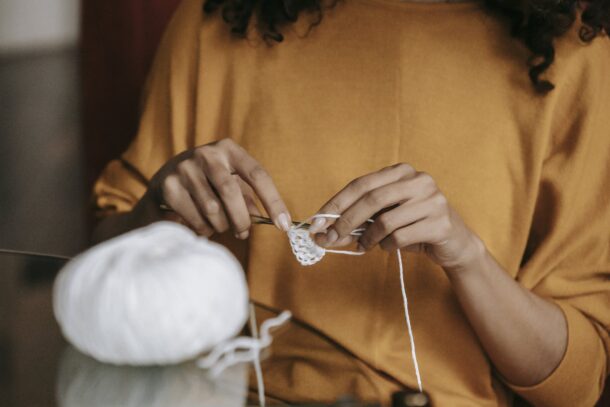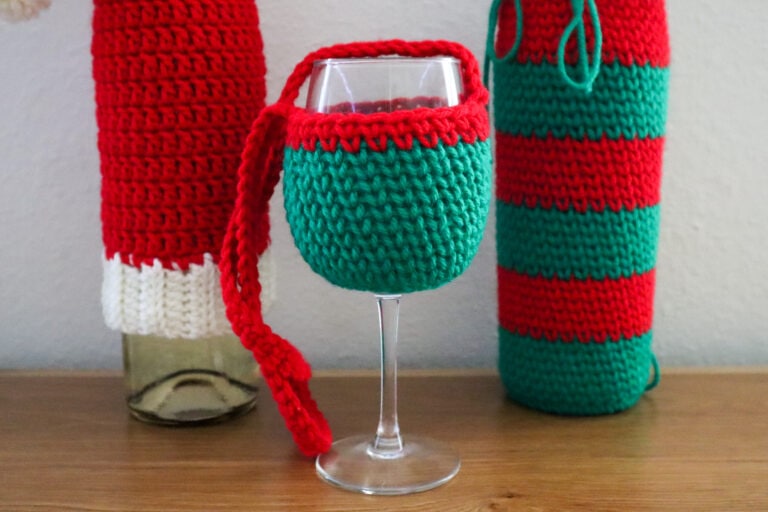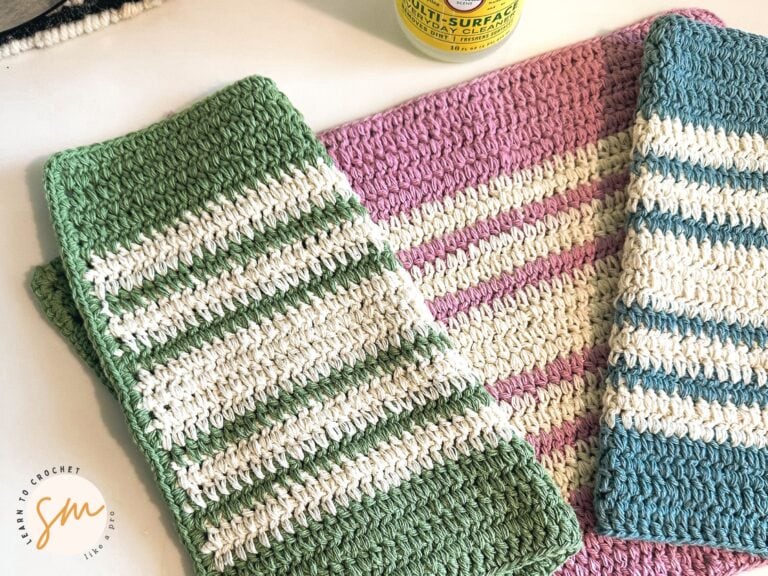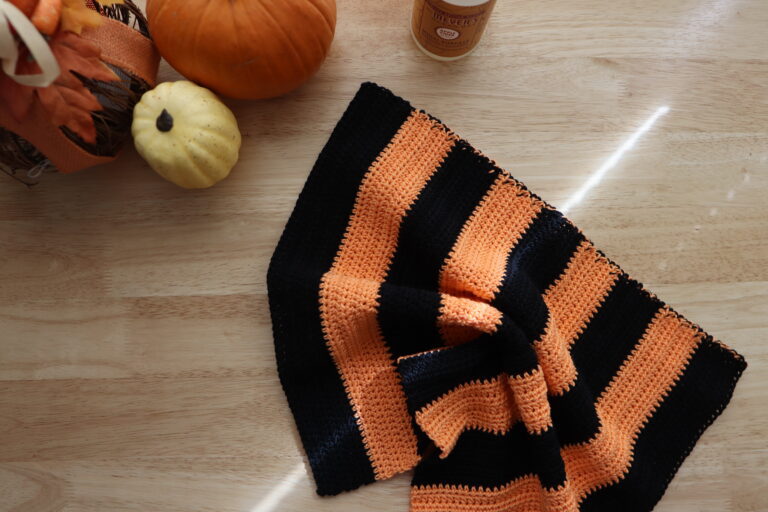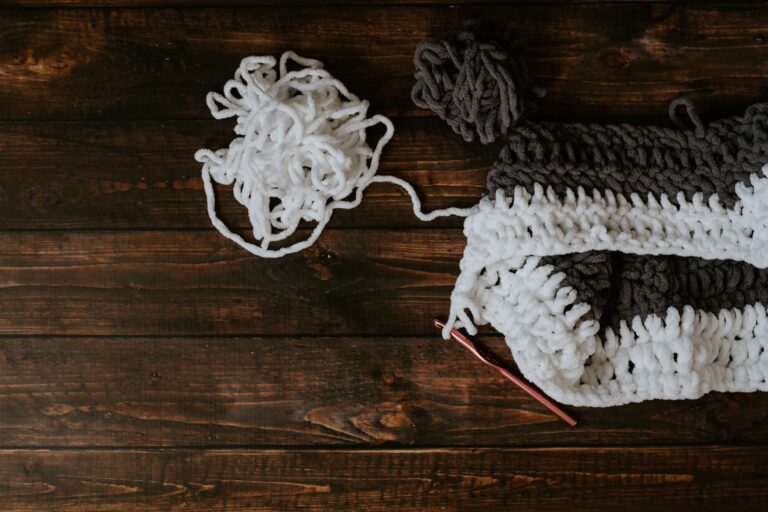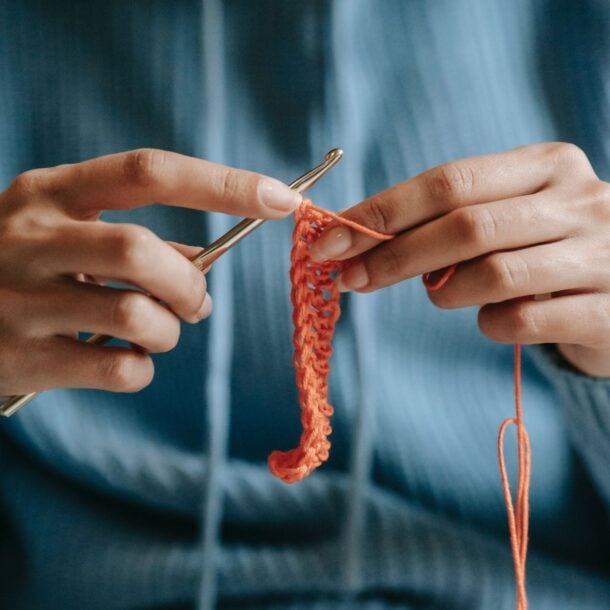Counting Crochet Stitches and Rows: Your Beginner Questions Answered
Are you tired of not understanding how in the world you should be counting crochet stitches and rows? Some aspects of crochet can be confusing when you’re first starting out if you can’t find the proper guidance. You’re in the right place if you’ve been asking yourself, “Does the turning chain at the beginning of the row count as a stitch?”, “Does the foundation chain count as a row?”, or “How do I count crochet rows in the round?”
Before I get started, I wanted you to be aware that the following crochet terms I use are in US terms. US and UK crochet terms are used differently. Here is a quick overview of the difference.
| US TERMS | UK TERMS |
| single crochet (sc) | double crochet (dc) |
| half double crochet (hdc) | half treble (htr) |
| double crochet (dc) | treble (tr) |
| treble (tr) | double treble (dtr) |
| double treble (dtr) | triple treble (trtr) |
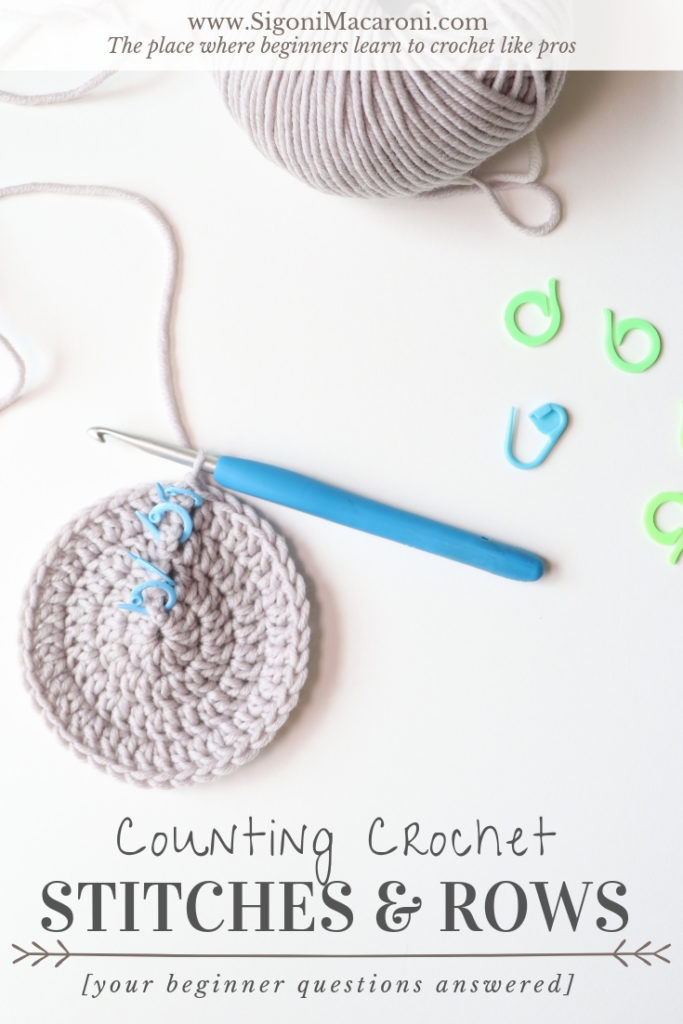
If counting stitches isn’t the only thing you’re struggling with, you just might love this brand new FREE training! 👇🏼👇🏼👇🏼
First, let’s go over some Beginner Crochet FAQs
Does the turning chain at the beginning of a row count as a stitch?
The dreaded, most frequently asked question: Does the turning chain at the beginning of a row count as a stitch?
If you have asked this question before, you are far from the only one. This is the most frequently asked question because you can’t really find a straight answer anywhere you look. This question alone frustrated me to no end when I first started crocheting.
Click here to learn all about those darn turning chains
If you’ve been struggling with your rows being uneven, it is very possible that this could be the culprit. After all, you can’t learn how to count your stitches if you’re confused about whether or not the chain counts as a stitch.
Start with the facts
The reason why so many people ask this question is
- Single Crochet: Chain 1 at the beginning of each row or round
- Half Double Crochet: Chain 2 at the beginning of each row or round
- Double Crochet: Chain 3 at the beginning of each row or round
- Treble Crochet: Chain 4 at the beginning of each row or round
- And so on
The turning chain at the beginning of each row is created in order to reach the height of the stitch. This makes it so that your stitches aren’t scrunched together.
Let’s take a look at an example:
With the double crochet stitch, you will chain however many stitches for your foundation chain. To begin your first row, you will double crochet into the fourth chain from your hook. Those three chains you skipped counts as a double crochet in your first row.
After you chain 3 and turn your work, you will not be placing your stitch into the very first stitch b
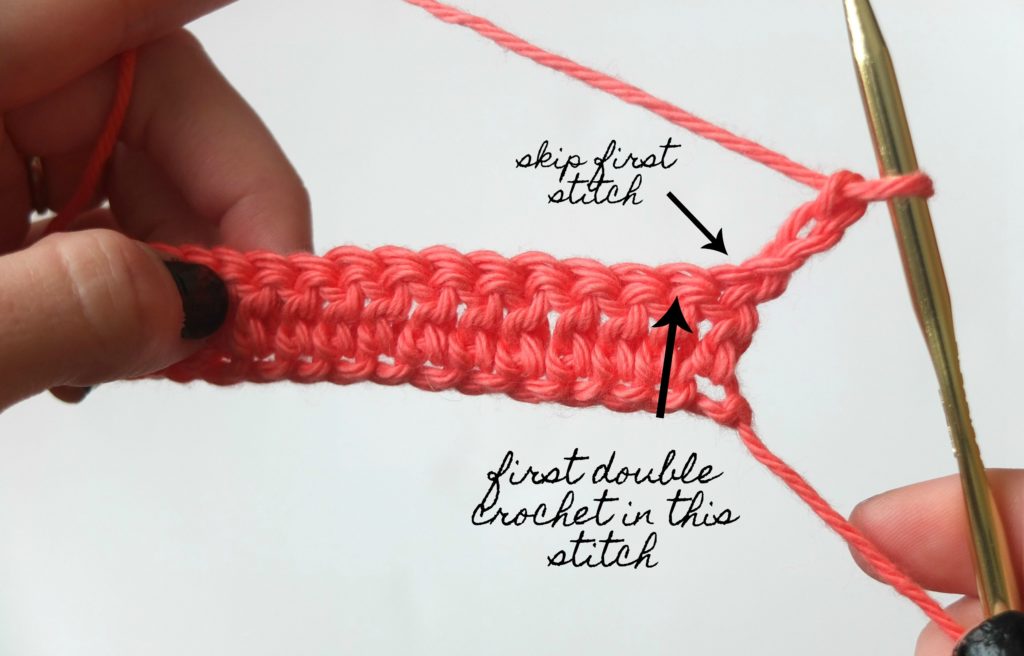
When you reach the end of the row, you will double crochet into the top chain from the chain 3 in the previous round.

When you’re finished with each row, count your stitches and make sure to include the chain 3 in the beginning.
Do you count the loop on your hook as a stitch?
The short answer: no.
When chaining, every time you create a chain stitch, there will be a loop around your hook. The chain on your hook does not count as a chain stitch.
There will always be a loop on your hook while you’re crocheting no matter what stitch you’re using. It never counts.
Does the foundation chain count as a row?
After you create your slip knot, you’ll create a row of chains that you will work stitches into later. This is called a foundation chain.
This foundation chain does not count as a row. The row of stitches that you work into the foundation chain does count as a row.
How to Count Rows in Crochet
When crocheting by rows, you will be turning your work at the end of each row. When you turn the row, you’re going to see the back side of the stitches you just completed. No matter what stitch you’re using, when crocheting in rows, you will see the front side of the stitch in one row and the back side of the stitch in the next row.
There are a few ways to make counting rows easier to manage:
- Pay attention to which side the stitch is facing
- Use a row counter
- Make a tally on a piece of paper every time you finish a row (I used to do this!)
- Use stitch markers to mark each row
Some stitches are more noticeable than others. For example, single crochet stitches are smaller and closer together while treble crochet stitches are tall and spaced apart.
Also, the foundation chain itself does not count as a row. Once you’ve worked your stitches into those chains, then you’ve completed your first row. So the foundation row always counts as a row.
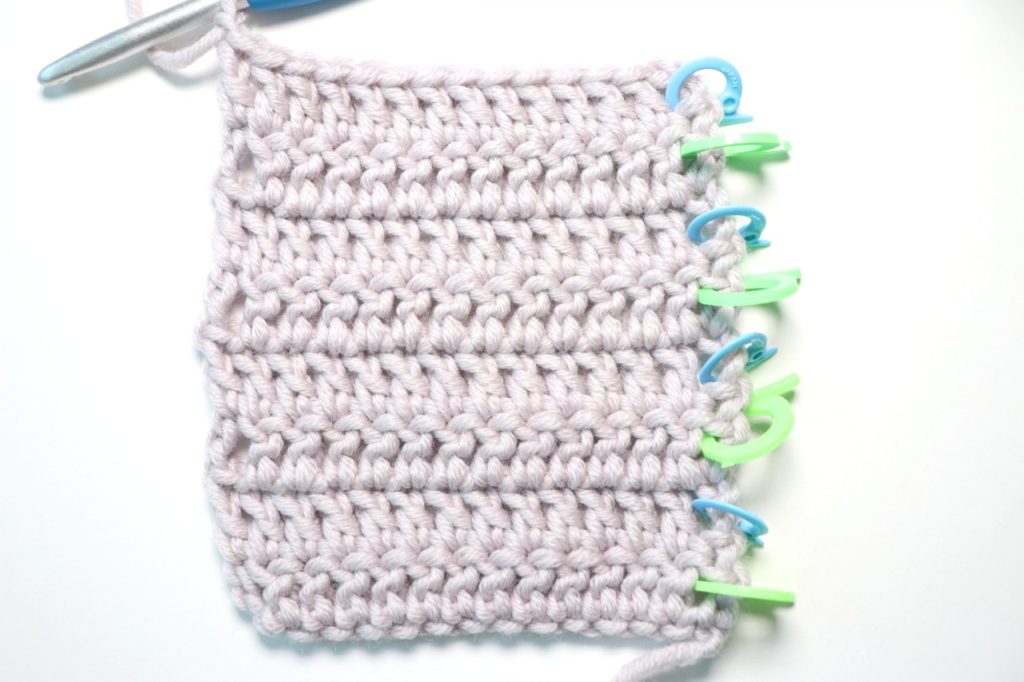
How to Count Stitches in Crochet
There are two ways you can count your crochet stitches.
- Count by the post
- Count by the ‘v’ stitch at the top of each row
Again, some stitches are easier to count than others. The taller stitches (the double crochet and treble crochet) are easier to count the post of the stitch because the stitch is so tall. With the single crochet and half double crochet, it may be easier to count the ‘v’ stitch at the top.
Remember, the loop on your hook at the end of each row does not count as a stitch!
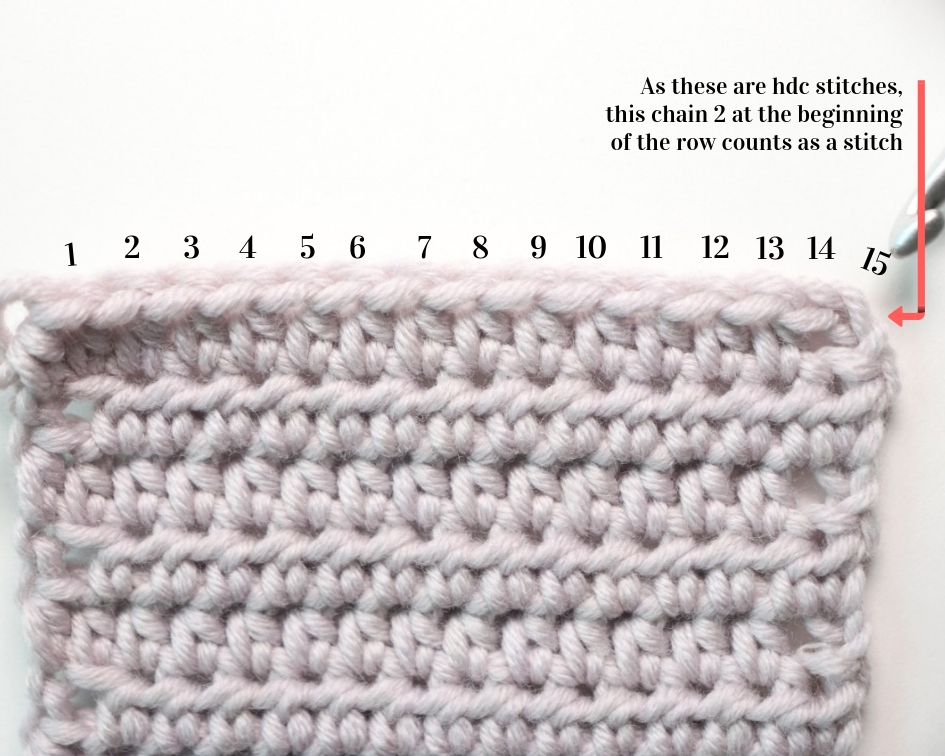
Counting and Identifying Single Crochet Stitches & Rows
As I said earlier, single crochet stitches are the hardest stitches to count because they are smaller and closer together.
With single crochet stitches, the chain 1 at the beginning of each row almost never counts as a stitch (unless stated otherwise). I will go more into detail about the chains at the beginning counting as stitches towards the bottom of this post.
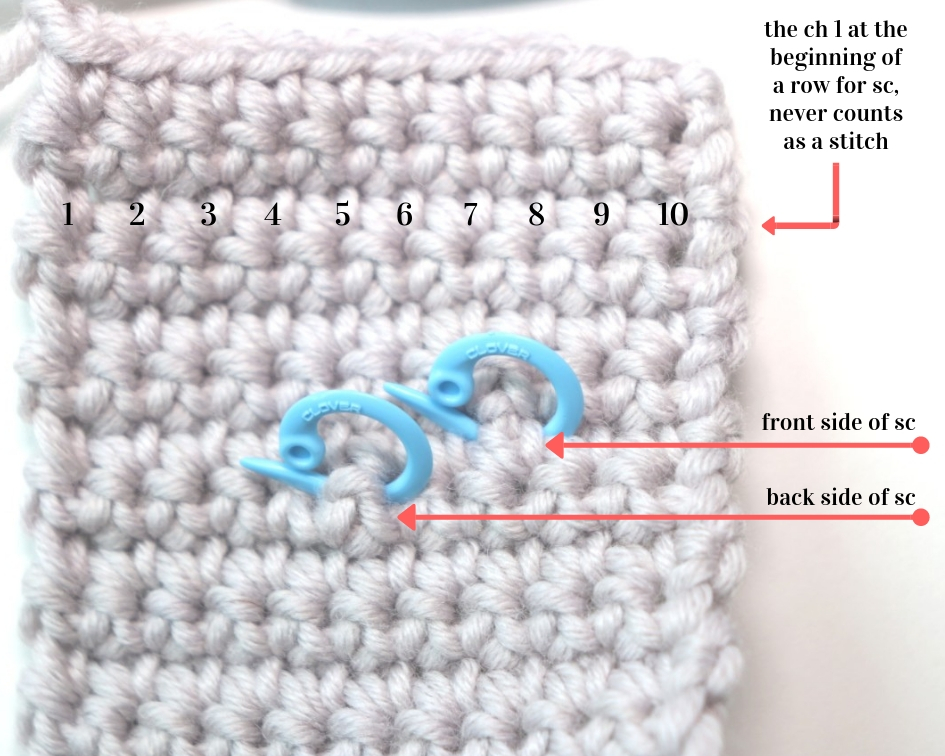
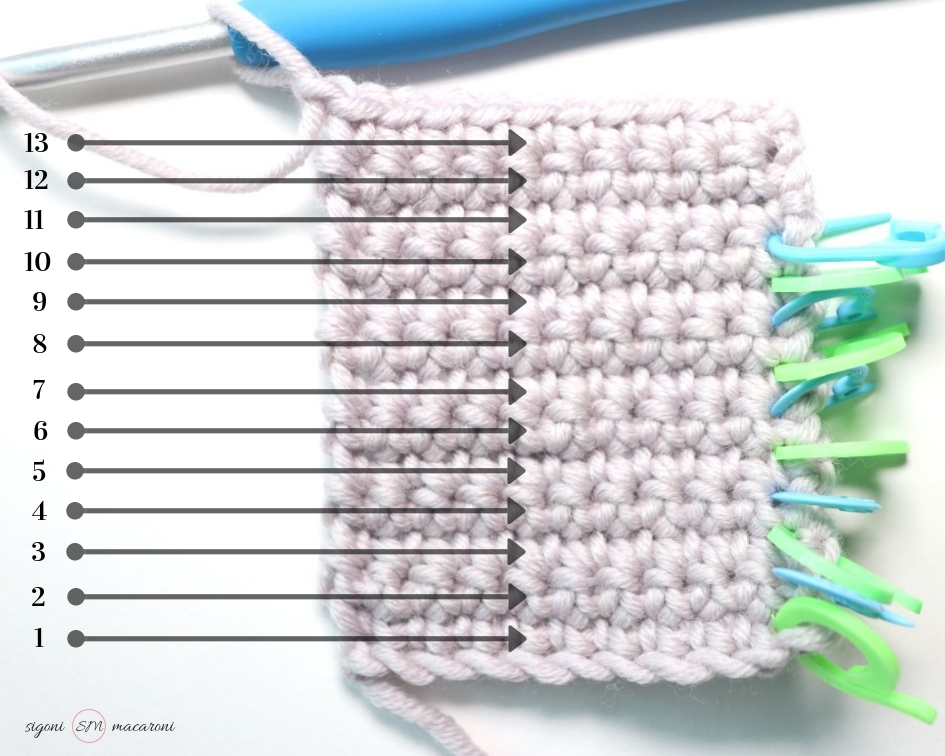
Counting and Identifying Half Double Crochet Stitches & Rows
**2021 UPDATE** The chain 2 turning chain for the half double crochet actually DOES NOT count as a stitch, unless the pattern you’re working on states otherwise. Just to clear up the technicality.
Half double crochet stitches are a little taller and look a little different from front to back. This makes it easier to identify than single crochet stitches, but they can still be a little tricky.
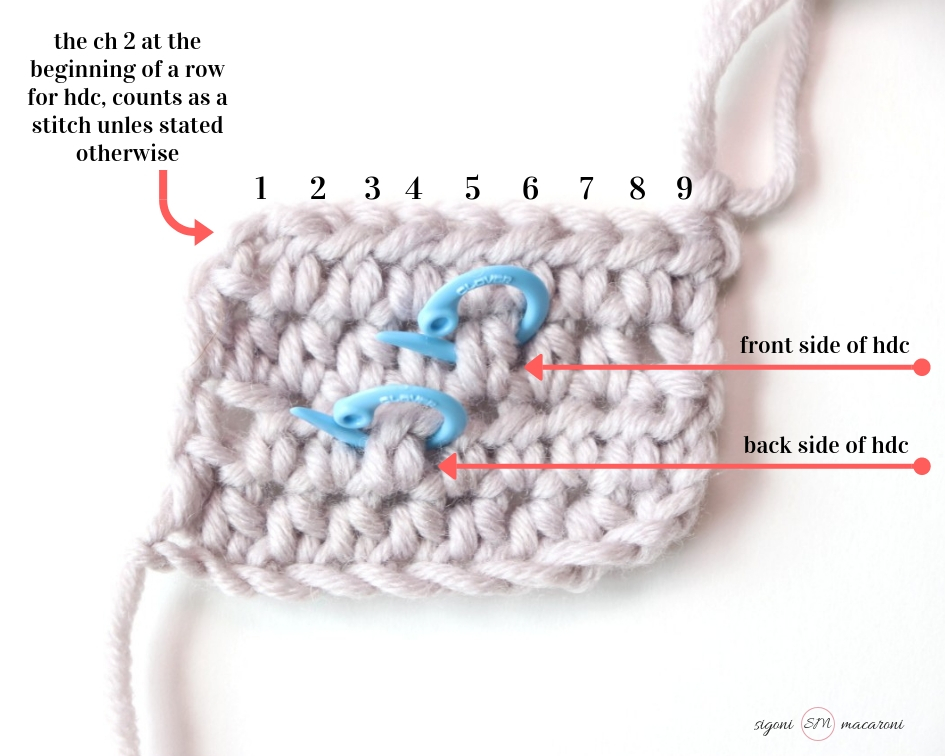
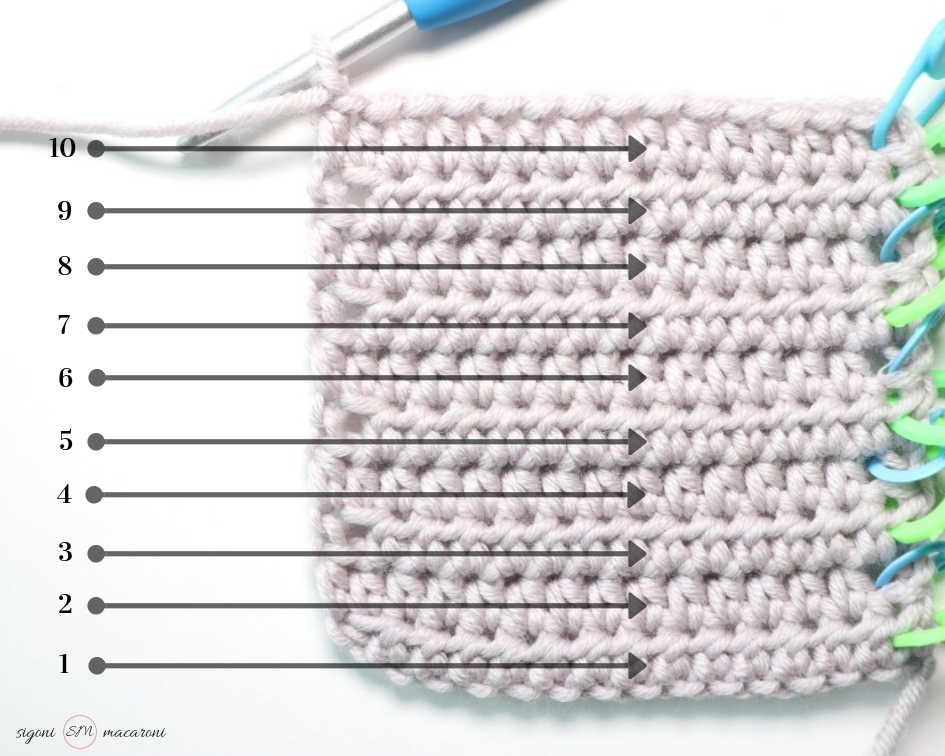
Counting and Identifying Double and Treble Crochet Stitches & Rows
Counting double and treble crochet stitches are easier than both single and half double. The height of both of these stitches make them easy to identify, as well as the small gaps they leave in between.
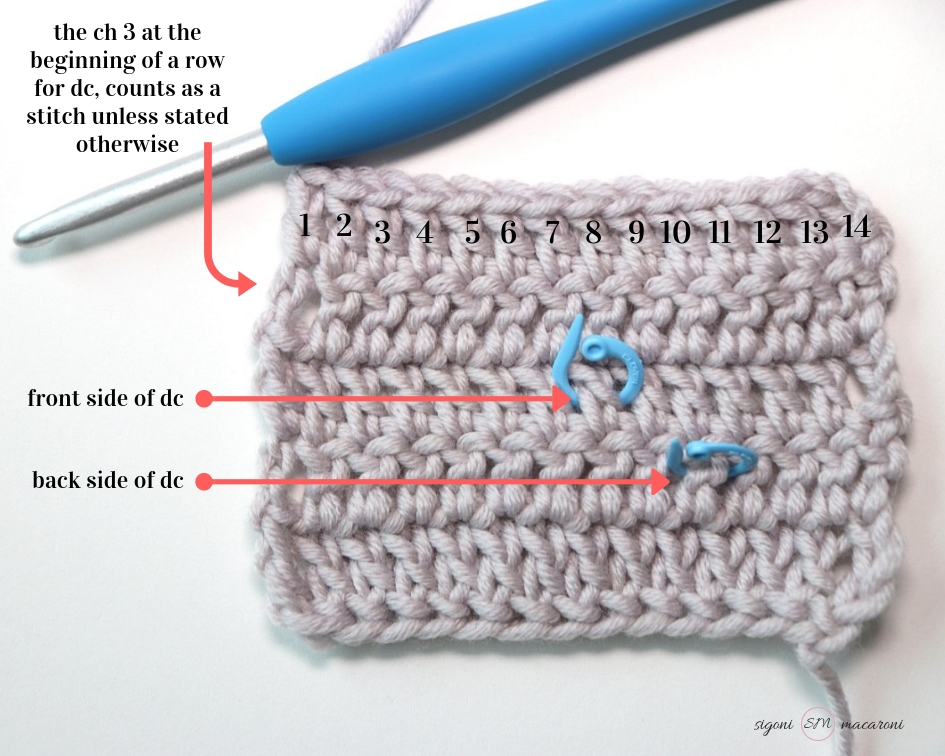
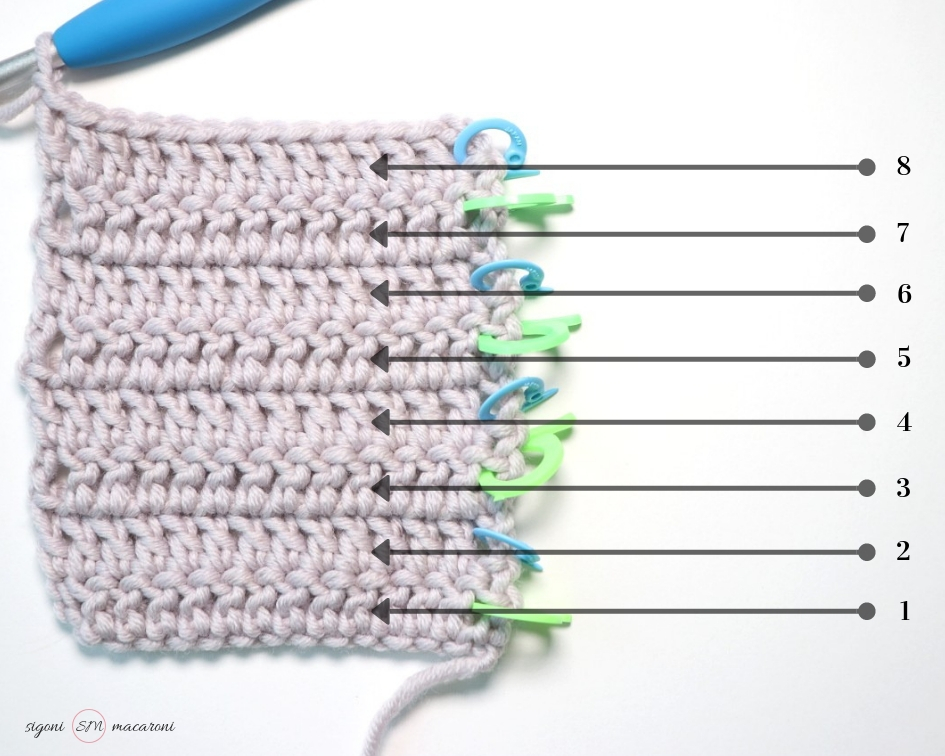
Counting Crochet Stitches in the Round
As with working in rows, the chain at the beginning of the round will also count as a stitch (with the exception of single crochet).
In my examples above and below, you will always find me counting the stitch at the beginning of my row or round. Remember that depending on the designer, this may not always be the case. If the pattern you’re working on mentions the chain at the beginning counting as a stitch, you will count the way I’m about to show you. If the pattern states that you will not be counting the stitch, then you will chain however many the pattern states and the exact number of stitches required.
Example for Counting Crochet Stitches in the Round
In the example below, you will see one round of double crochet stitches. I created a magic circle, chained 3, and placed 9 double crochets within my magic circle. Because the chain 3 at the beginning of the row counts as a stitch, we have 10 double crochets total.
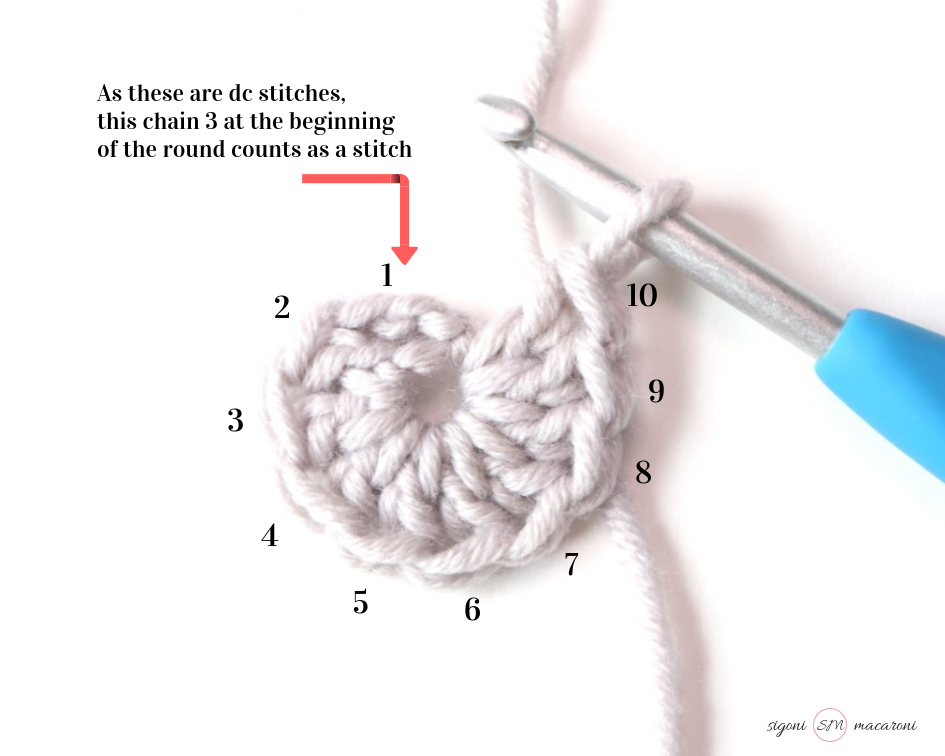
To finish this round, you will slip stitch into the top chain of the chain 3 we made in the beginning. When you create this slip stitch, it makes it looks like a stitch you would work into in the next round. You will not be working into this stitch. (It’s also known as a false stitch. We will talk about this more below)
In order for our rounds to grow in size, we will be placing an increase in each stitch around. An increase means two double crochets in the same stitch.
To start the second round, your first double crochet of the round will be in the base of the chain 3 you just created. This will count as two double crochets in the same stitch (an increase).
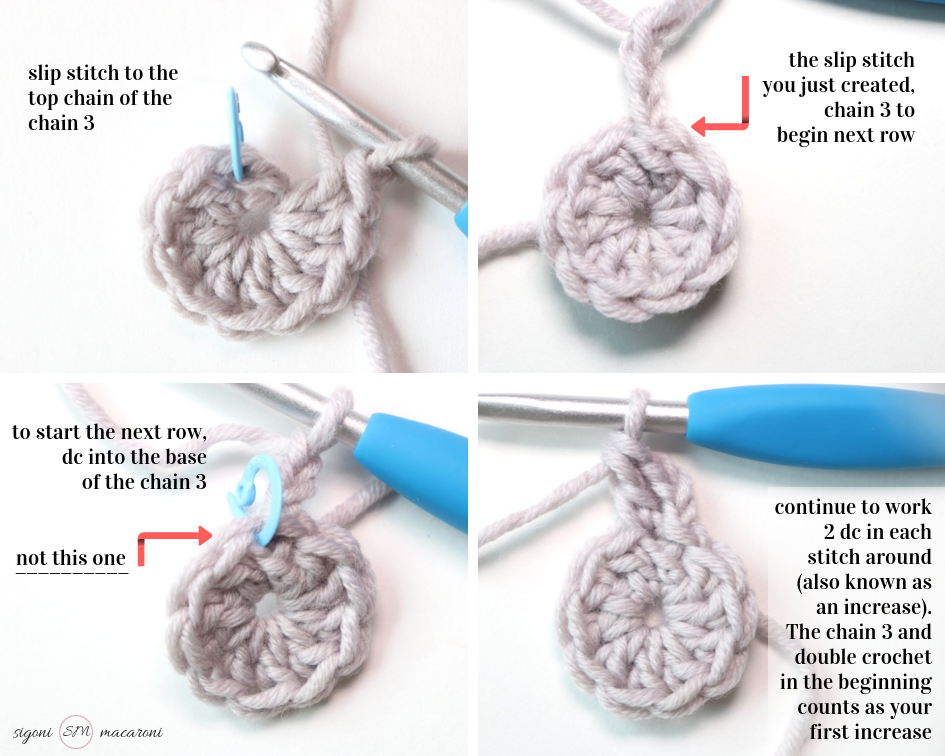
Continue increasing in each stitch around (2dc in each stitch). When you reach the final stitch, you will have 20 stitches (if you started with 10 double crochets in your magic circle like I did).
Now we’re back where our false stitch is. Skip this stitch. Slip stitch into the top chain of your chain 3 from the beginning of the row (the top chain is located next to the 1 in the photo below).
Now that we know how to count crochet stitches in the round, let’s talk about counting crochet rows in the round.
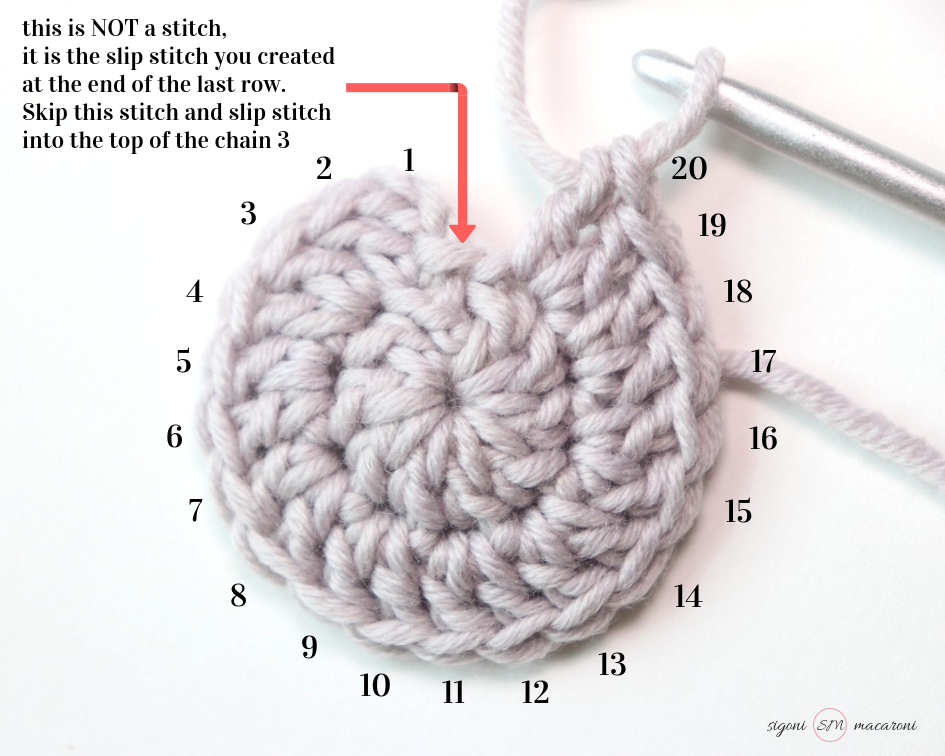
Counting Crochet Rows in the Round
Learning how to count crochet rows in the round is almost just as simple as counting rows. When counting rows in the round, we’re really supposed to call them rounds, not rows. So let’s count some rounds!
When crocheting in the round you’re usually creating a beanie or maybe amigurumi. I quickly went over earlier that in order to make our circle grow larger, we have to increase in each round.
Let’s break this down into rows so it’s easy to understand.
Typical Increases When Crocheting in the Round
- First Round: Crochet a certain amount of stitches into a magic circle or starting chain.
- Second Round: Increase in every stitch.
- Two stitches in each stitch around.
- Third Round: Increase in every other stitch.
- 2 stitches in the first stitch, 1 stitch in the next stitch. 2 stitches in the next stitch, 1 stitch in the next stitch, and so on.
- Fourth Round: Increase every 2 stitches.
- 2 stitches in the first stitch, 1 stitch in each of the next 2 stitches. 2 stitches in the next stitch, 1 stitch in each of the next 2 stitches, and so on.
- Fifth Round: Increase every 3 stitches.
- 2 stitches in the first stitch, 1 stitch in each of the next 3 stitches. 2 stitches in the next stitch, 1 stitch in each of the next 3 stitches, and so on.
Each round continues growing in this way (adding one more stitch in between each increase) until you’ve reached the size you’re going for.
If you need a more in depth explanation, you can find a step-by-step picture tutorial when I explain How to Crochet in the Round.
So let’s look at our rows. In the photo below, you will see 4 rounds of double crochet increases in this circle. The stitch marker marks the beginning chain for each row.
Let’s get another frequently asked crochet question out of the way.
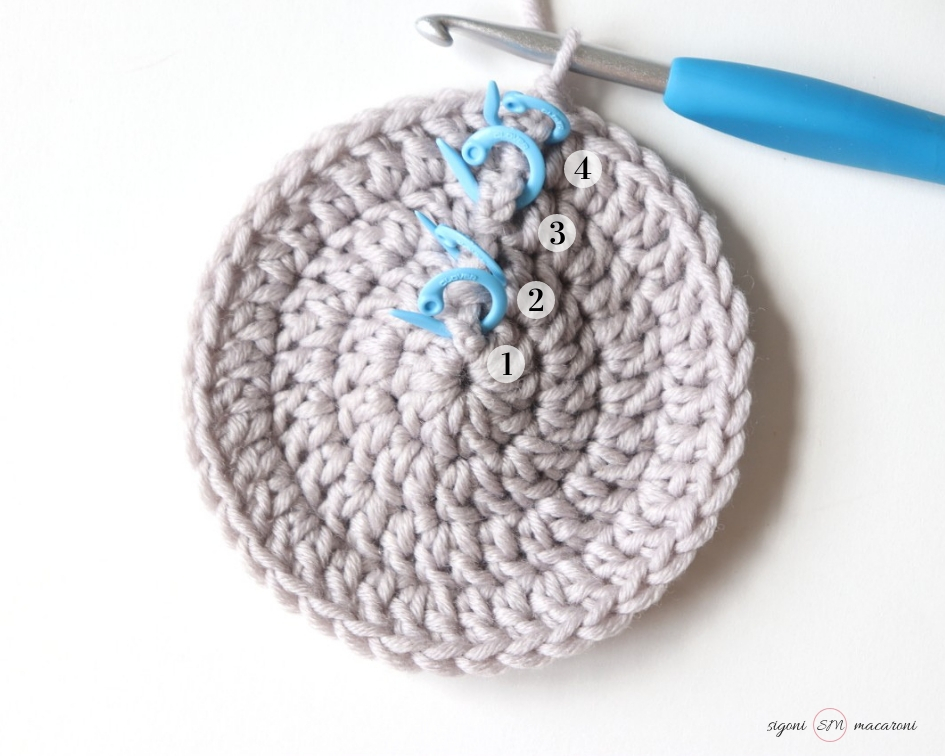
Why do a have a diagonal or slanted seam when I’m crocheting in the round?
A few of the ladies in my beginner’s facebook group were concerned they were doing something wrong and kept frogging their work. As you can see from the photo I shared above, this is totally normal! You’re not doing anything wrong.
There are a few ways you can get around this, including working continuously in the round. Nonetheless, we’re not going to get into any of those today because I don’t want to confuse you. All you need to know is that it is completely normal to have a diagonal or slanted seam when you’re working in the round.
As you progress, you can research ways to create an invisible seam when working in the round. For now, let’s just stick with the basics.
In Conclusion
Learning how you should be counting crochet stitches and rows is something that will come over time with the more crochet projects you create. The purpose of this post is to make that journey as stress-free as possible.
When crocheting in rows, the stitches and rows may be easier to count if you can recognize each stitch. We went over how to identify the front and back of a stitch for each of the three basic stitches. We also learned the easy ways to count the stitch itself: by the post or the “v” shape of the stitch at the top of each row.
Plus, four of the most frequently asked crochet questions were answered!
- Does the turning chain at the beginning of the row count as a stitch?
- Do you count the loop around the hook as a stitch?
- Does the foundation chain count as a row?
- Why do a have a diagonal or slanted seam when I’m crocheting in the round?
This entire tutorial on counting your crochet stitches and rows has been jam packed with so many tips, tricks, and photos! Let me know if you have any additional questions or if there was something that I missed.
The Crochet’dy Bunch FB Group
By the way, are you a member of the Crochet’dy Bunch Facebook Group? It’s a place where beginners come to get one-on-one help, their questions answered, and a tight-knit community for ladies who want to share their love for crochet. The group is an added bonus for those on my email list! Sign up for free using the form below and not only will you receive access to the group, you will also receive additional free goodies!
If you don’t want to join the group, but you would like to receive weekly emails, you can sign up here (this includes access to my free resource library!)

